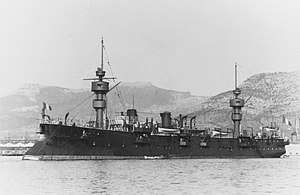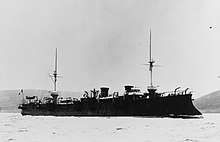French cruiser Jean Bart
Jean Bart was a protected cruiser of the Alger class built for the French Navy in the late 1880s and early 1890s. The second member of the class of three ships, Jean Bart and her sister ships were ordered during the tenure of Admiral Théophile Aube as Minister of Marine according to the theories of the Jeune École doctrine. The ships were intended as long-range commerce raiders, and they were armed with a main battery of four 164 mm (6.5 in) guns, were protected by an armor deck that was 50 to 100 mm (2 to 4 in) thick, and were capable of steaming at a top speed of 19.5 knots (36.1 km/h; 22.4 mph).
 Jean Bart off Toulon early in her career | |
| History | |
|---|---|
| Name: | Jean Bart |
| Builder: | Arsenal de Rochefort |
| Laid down: | September 1887 |
| Launched: | November 1889 |
| Completed: | 1891 |
| Fate: | Wrecked, 11 February 1907 |
| General characteristics | |
| Class and type: | Alger-class cruiser |
| Displacement: | 4,044 long tons (4,109 t) |
| Length: | 105 m (344 ft 6 in) pp |
| Beam: | 12.98 m (42 ft 7 in) |
| Draft: | 6.10 to 6.45 m (20 ft 0 in to 21 ft 2 in) |
| Installed power: |
|
| Propulsion: |
|
| Speed: | 19 to 19.5 knots (35.2 to 36.1 km/h; 21.9 to 22.4 mph) |
| Range: | 3,200 nmi (5,900 km; 3,700 mi) at 10 knots (19 km/h; 12 mph) |
| Complement: | 387–405 |
| Armament: |
|
| Armor: |
|
Jean Bart served with the Mediterranean Squadron for the first two years of her career, thereafter being transferred to the Northern Squadron. During this period, she took part in training exercises with the fleet. In 1897, the ship was modernized with new masts and electric search lights. She was deployed to French Indochina in Southeast Asia in 1898 and she was part of the French squadron that responded to the Boxer Uprising in Qing China. Jean Bart underwent a second refit between 1903 and 1906 that included new water-tube boilers that improved her performance. She saw little use afterward, as she ran aground off the Western Sahara in early 1907 and could not be refloated.
Design

Admiral Théophile Aube, the French Minister of Marine in the mid-1880s, was an ardent supporter of the Jeune École doctrine that emphasized long-range commerce raiding cruisers. Upon becoming the naval minister in 1886, Aube called for the construction of six large and ten small protected cruisers, though by the end of his tenure in 1887, the program had been reduced to five large, two medium, and six small cruisers. Aube ordered the first two Alger-class cruisers to fulfill the requirements for the first set of large cruisers, and his successor, Édouard Barbey, authorized the third.[1][2] The three Algers proved to be the last of the initial series of commerce raiders built under the influence of the Jeune École.[3]
Jean Bart was 105 m (344 ft 6 in) long between perpendiculars, with a beam of 12.98 m (42 ft 7 in) and a draft of 6.10 to 6.45 m (20 ft 0 in to 21 ft 2 in). She displaced 4,044 long tons (4,109 t). Her crew varied over the course of her career, amounting to 387–405 officers and enlisted men. The ship's propulsion system consisted of a pair of triple-expansion steam engines driving two screw propellers. Steam was provided by eight coal-burning fire-tube boilers that were ducted into two funnels. Her machinery was rated to produce 8,000 indicated horsepower (6,000 kW) for a top speed of 19 to 19.5 knots (35.2 to 36.1 km/h; 21.9 to 22.4 mph).[4] She had a cruising radius of 3,200 nautical miles (5,900 km; 3,700 mi) at 10 knots (19 km/h; 12 mph).[3]
The ship was armed with a main battery of four 164 mm (6.5 in) 28-caliber guns and six 138 mm (5.4 in) 30-cal. guns. All of these guns were placed in individual pivot mounts; the 164 mm guns were in sponsons located fore and aft, with two guns per broadside. Four of the 138 mm guns were in sponsons between the 164 mm guns, one was in an embrasure in the forecastle and the last was in a swivel mount on the stern. For close-range defense against torpedo boats, she carried a pair of 65 mm (2.6 in) 9-pounder guns, eight 47 mm (1.9 in) 3-pounder Hotchkiss guns, and eight 37 mm (1.5 in) Hotchkiss revolver cannon. She was also armed with five 350 mm (14 in) torpedo tubes in her hull above the waterline. Armor protection consisted of a curved armor deck that was 50 to 100 mm (2 to 4 in) thick, along with 50 to 75 mm (2 to 3 in) plating on the conning tower.[4]
Service history
Work on Jean Bart began with her keel laying at the Arsenal de Rochefort shipyard in Rochefort in September 1887. She was launched in November 1889 and was completed in 1891.[4] By 1893, Jean Bart had been assigned to the Mediterranean Squadron, the main French battle fleet. At that time, the unit also included several modern ironclad warships, the armored cruiser Dupuy de Lome, and the protected cruisers Amiral Cécille, Cosmao, Troude, and Lalande.[5] The following year, she continued to operate with the squadron. She took part in annual training exercises that year to evaluate the effectiveness of the French coastal defense system. The squadron went to sea on 15 July and began the operations the next day, which lasted until 29 July; during operations on the 18th, Jean Bart collided with the torpedo boat Grondeur. She was not damaged, but Grondeur suffered damage to her bow and had to return to port for repairs. The maneuvers demonstrated the usefulness of torpedo boat flotillas in coastal defense, but highlighted that France's coastal defense system in the English Channel was not yet complete.[6]

In 1895, she was transferred to the Northern Squadron, which was kept in commission for only four months per year. The unit at that time consisted of the coastal defense ship Furieux, the ironclads Requin, Victorieuse, and Suffren, the armored cruiser Latouche-Tréville, and the protected cruisers Coëtlogon and Surcouf.[7] By 1896, she was reduced to the 2nd category of reserve, along with several old coastal defense ships, ironclads, and other cruisers. They were retained in a state that allowed them to be mobilized in the event of a major war.[8] While out of service in 1897, the ship was refitted, which included replacing her military masts with lighter pole masts; the French reasoned that the smaller masts would make her less visible at a distance. The light guns that had been carried in the military masts' tops were relocated to her upper deck and superstructure. Electric search lights were installed on the pole masts.[9]
With the beginning of the unrest that led to the Boxer Uprising in Qing China in 1898, many European colonial powers began to reinforce their naval forces in East Asia. Jean Bart was mobilized that year and sent to the region, and at that time, the French squadron in the Far East consisted of the old ironclad Bayard, the protected cruisers Descartes and Pascal, and the unprotected cruiser Duguay-Trouin.[10] Jean Bart remained on station in East Asia through early 1901; at that time, eight other cruisers were assigned to the station.[11] By May, Jean Bart had been recalled to France, where she was reduced to reserve in Lorient.[12]
The ship was modernized in 1903, the most significant improvement being the replacement of her original boilers with Niclausse-type water-tube boilers, which increased her performance to 20 knots (37 km/h; 23 mph) from 10,000 indicated horsepower (7,500 kW).[4] The work was completed by 1906, and she conducted sea trials in October.[13] On 11 February 1907, Jean Bart was wrecked off the coast of Western Sahara,[4] near Cape Barbas. This was the first in a series of disasters for the French Navy that year, which also included the wrecking of the armored cruiser Chanzy off the coast of China and the destruction of the pre-dreadnought battleship Iéna by an accidental magazine fire. The captains of both cruisers were both brought before courts-martial, both convicted of negligent ship handling, and both barred from further commands for three years.[14]
Notes
- Gardiner, pp. 308–310.
- Ropp, pp. 171–172, 189–190.
- Fisher, p. 238.
- Gardiner, p. 310.
- Brassey 1893, p. 70.
- Barry, pp. 201–208, 213.
- Brassey 1895, p. 50.
- Weyl, p. 96.
- Garbett 1897, p. 341.
- Brassey 1898, pp. 59–60.
- Jordan & Caresse, p. 218.
- Garbett 1901, p. 611.
- Brassey & Leyland, p. 14.
- Leyland, pp. 111–113.
References
| Wikimedia Commons has media related to Jean Bart (ship, 1886). |
- Barry, E. B. (1895). "The Naval Manoeuvres of 1894". The United Service: A Monthly Review of Military and Naval Affairs. Philadelphia: L. R. Hamersly & Co. XII: 177–213. OCLC 228667393.
- Brassey, Thomas A. (1893). "Chapter IV: Relative Strength". The Naval Annual. Portsmouth: J. Griffin & Co.: 66–73. OCLC 496786828.
- Brassey, Thomas A. (1895). "Chapter III: Relative Strength". The Naval Annual. Portsmouth: J. Griffin & Co.: 49–59. OCLC 496786828.
- Brassey, Thomas A. (1898). "Chapter III: Relative Strength". The Naval Annual. Portsmouth: J. Griffin & Co.: 56–66. OCLC 496786828.
- Brassey, Thomas A. & Leyland, John (1906). "Chapter II: Foreign Navies". The Naval Annual. Portsmouth: J. Griffin & Co.: 8–37. OCLC 496786828.
- Fisher, Edward C., ed. (1969). "157/67 French Protected Cruiser Isly". Warship International. Toledo: International Naval Research Organization. VI (3): 238. ISSN 0043-0374.
- Garbett, H., ed. (March 1897). "Naval Notes: France". Journal of the Royal United Service Institution. London: J. J. Keliher & Co. XLI (229): 341–348. OCLC 1077860366.
- Garbett, H., ed. (May 1901). "Naval Notes: France". Journal of the Royal United Service Institution. London: J. J. Keliher & Co. XVI (279): 610–614. OCLC 1077860366.
- Gardiner, Robert, ed. (1979). Conway's All the World's Fighting Ships 1860–1905. London: Conway Maritime Press. ISBN 978-0-85177-133-5.
- Jordan, John & Caresse, Philippe (2017). French Battleships of World War One. Annapolis: Naval Institute Press. ISBN 978-1-59114-639-1.
- Leyland, John (1908). Brassey, Thomas A. (ed.). "Chapter VII: The Personnel of the French Navy". The Naval Annual. Portsmouth: J. Griffin & Co.: 64–82. OCLC 496786828.
- Ropp, Theodore (1987). Roberts, Stephen S. (ed.). The Development of a Modern Navy: French Naval Policy, 1871–1904. Annapolis: Naval Institute Press. ISBN 978-0-87021-141-6.
- Weyl, E. (1896). Brassey, Thomas A. (ed.). "Chapter IV: The French Navy". The Naval Annual. Portsmouth: J. Griffin & Co.: 61–72. OCLC 496786828.